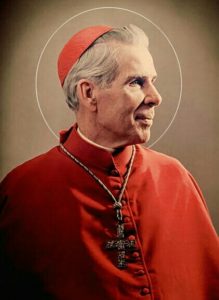CIRCUMCISION of CHRIST
from: LIFE OF CHRIST
by The Most Reverend Fulton J. Sheen, PH.D., D.D., Auxiliary Bishop of New York

National Director, World Mission Society for the Propagation of the Faith
McGraw-Hill Book Company, New York, 1958
Chapter 2- Early Life of Christ (pages 32-33)
When eight days had passed, and
The boy must be circumcised,
He was called Jesus, the name which
The angel had given Him before
Ever He was conceived in the womb.
Luke 2:21
Circumcision was the symbol of the covenant between God and Abraham and his seed, and took place on the eighth day. Circumcision presumed that the person circumcised was a sinner. The Babe was now taking the sinner’s place- something He was to do all through His life. Circumcision was a sign and token of membership in the body of Israel. Mere human birth did not bring a child into the body of God’s chosen people. Another rite was required, as recorded in the Book of Genesis.
Then God said to Abraham, thou too
Shalt observe this covenant of Mine,
Thou and the race that shall follow thee,
Generation after generation.
That is the covenant you shall keep with Me,
Thou and thine; every male child
Of yours shall be circumcised.
Genesis 17: 9-11
Circumcision in the Old Testament was a prefiguring of Baptism in the New Testament. Both symbolize a renunciation of the flesh with its sins. The first was done by wounding of the body; the second, by cleansing the soul. The first incorporated the child into the body of Israel; the second incorporates the child into the body of the new Israel or the Church. The term “Circumcision” was later used in the Scriptures to reveal the spiritual significance of applying the Cross to the flesh through self-discipline. Moses, in the Book of Deuteronomy clearly spoke of circumcising the heart. Jeremias also used the same expression. St. Stephen, in his last address before being killed, told his hearers that they were uncircumcised in heart and ears. By submitting to this rite, which He need not have done because He was sinless, the Son of God made man satisfied the demands of His nation, just as He was to keep all the other Hebrew regulations. He kept the Passover; He observed the Sabbath; He went up to the Feasts; He obeyed the Old Law until the time came for Him to fulfill it by realizing and spiritualizing its shadowy prefigurements of God’s dispensation.
In the Circumcision of the Divine Child there was a dim suggestion and hint of Calvary, in the precocious surrendering of blood. The shadow of the Cross was already hanging over a Child eight days old. He would have seven bloodsheddings of which this was the first, the others being the Agony in the Garden, the Scourging, the Crowning with Thorns, the Way of the Cross, the Crucifixion, and the Piercing of His Heart. But whenever there was an indication of Calvary, there was also some sign of glory; and it was at this moment when He was anticipating Calvary by shedding His blood that the name of Jesus was bestowed on Him.
A Child only eight days old was already beginning the bloodshedding that would fulfill His perfect manhood. The cradle was tinged with crimson, a token of Calvary. The Precious Blood was beginning its long pilgrimage. Within an octave of His birth, Christ obeyed a law of which He Himself was the Author, a law which was to find its last application in Him. There had been sin in human blood, and now blood was already being poured out to do away with sin. As the East catches at sunset the colors of the West, so does the Circumcision reflect Calvary.
Must He begin redeeming all at once? Cannot the Cross wait? There will be plenty of time for it. Coming straight from the Father’s arms to the arms of His earthly mother, He is carried in her arms to His first Calvary. Many years later He will be taken from her arms again, after the bruising of the flesh on the Cross, when the Father’s work is done.
NIHIL OBSTAT
John A. Goodwin, J.C.D., Censor Librorum
IMPRIMATUR:
Francis Cardinal Spellman, Archbishop of New York